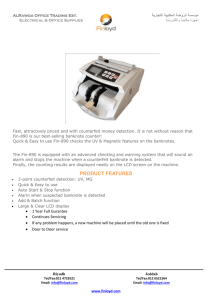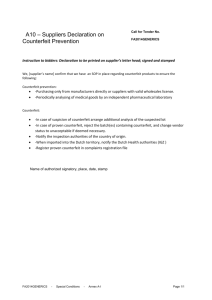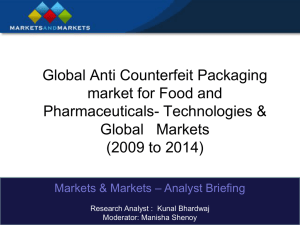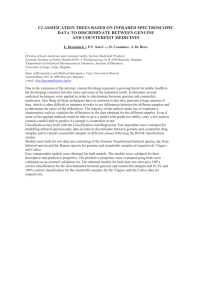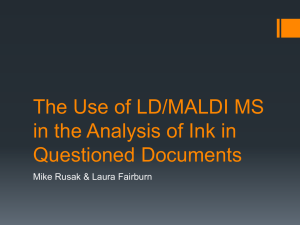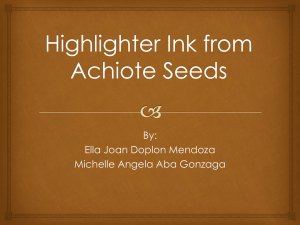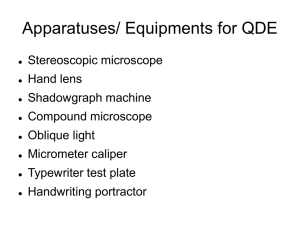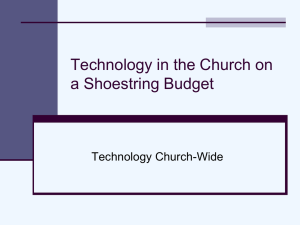powerpoint format
advertisement
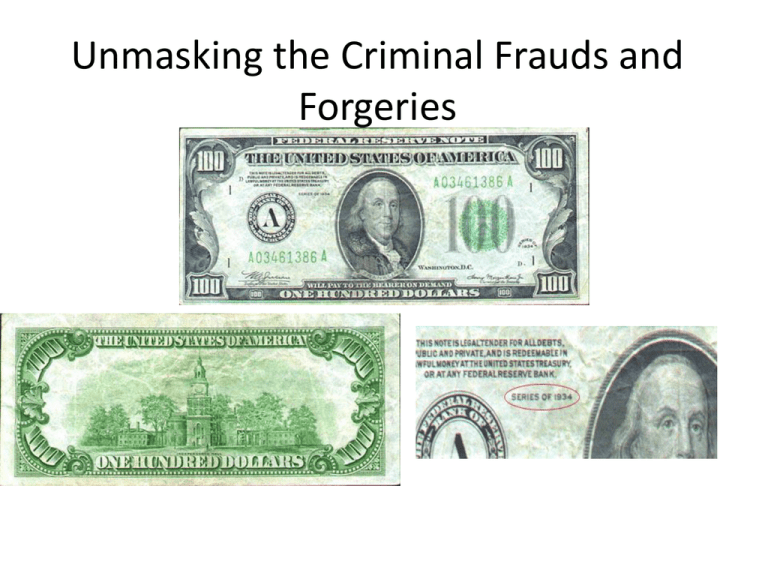
Unmasking the Criminal Frauds and Forgeries In news Dec 7, 2010 http://news.yahoo.com/s/yblog_thelookout/2 0101206/us_yblog_thelookout/governmentcant-print-money-properly • US Treasury printed a LOT of $100 bill that had a crease (fold) in them when the paper went thru the machine for printing, causing a flaw. • $110 billion worth Technically they exist, but are out of circulation. They are worth more than face value. $500 Security Features: • • • • • • • • • Watermarks security threads metameric inks (IR scan) see-through Intaglio visual impair devices ascending serial numbers OVIs (optically variable inks) latent images • • • • • • • • • lift twins fibers Holograms Foils metallic inks moiré s (graphic overlays) anti-copies microprints, UV (ultra violet) ink/security thread/fibers. Watermarks • A watermark is the most common anti-copy feature and is embedded into the note with a special wire mesh usually stamped by a copper wire and causes a thinning in the paper fibers, thus revealing an image. Watermarks Holograms Found on: • Money notes • Driver’s liscenses • ID cards • Credit cards Defined as: A technique that allows the light scattered from an object to be recorded and later reconstructed so that it appears as if the object is in the same position relative to the recording medium as it was when recorded Holograms See-through Security device that makes counterfeiting harder Counterfeit detector pen • Normal wood-based paper= counterfeit money • The counterfeit detector pen is extremely simple. It contains an iodine solution that reacts with the starch in wood-based paper to create a black stain. • When the solution is applied to the fiber-based paper used in real bills, no discoloration occurs. • The pen does nothing but detect bills printed on normal copier paper instead of the fine papers used by the U.S. Treasury How Stuff Works http://money.howstuffworks.com/question108.htm Patented counterfeit money detector pen detects authenticity on U S currency instantly Good on al U S currency series 1959 and after Mark a small line on the U S bill - a light amber mark passes the test If the mark turn black or dark brown - bill is suspect Replace cap immediately after use Cellulose is in wood • Normal paper -- including notebook paper, newspaper, construction paper -- is all made out of cellulose, which comes from trees. The trees are chemically broken down into their individual wood fibers, and the cellulose fibers are chosen and formed into very thin sheets to create paper. Counterfeit $20’s Intaglio • Printmaking techniques in which the image is incised into a surface, known as the matrix or plate. Copper or zinc plates are used as a surface, and the incisions are created by etching or engraving. Ascending Serial Numbers 56789 1234 USA • TWO MOST IMPORTANT SECURITY FEATURES OF US NOTES ARE the ink and paper. • Examination of ink and paper can be done • Watermarks can be investigated Inks & Papers • Four basic types of ink 1. Modern Ink – Contain dye, iron salts in a suspension of gallic or tannic acid 2. India Ink – Made of carbon particles and also called carbon black ink 3. Arabic Ink – Synthetic dyes with different polymers and acids 4. Ball Point pen ink – Synthetic dyes with solvents and additives. Counterfeit Currency • Notes of the $500, $1,000, $5,000, and $10,000 denominations have not been printed for many years and are being withdrawn from circulation. • The portraits appearing on these notes are: – – – – McKinley on the $500 Cleveland on the $1,000 Madison on the $5,000 Chase on the $10,000. • Why no more large denominations of bills? • How many times can a bill be folded before it has to be replaced? • Large denomination bills can be seen at the Smithsonian • 4000 $1000 bills $5000 $100,000 • This bill was only used for official transactions between Federal Reserve banks (1860’s) Counterfeit Currency • Jackson Portrait • A common variation occurs in the portrait of Andrew Jackson on the $20 note. • In the 1934 and 1950 series years, he is depicted with one more finger showing than on notes of other series years. Photo: http://www.ustreas.gov/usss/money_design_features.shtml Counterfeit Currency Photo: http://www.ustreas.gov/usss/money_design_features.shtml The EURO is used in 22 countries 1) Andorra 2) Austria 3) Belgium 4) Cyprus 5) Finland 6) France 7) Germany 8) Greece 9) Ireland 10) Italy 11) Kosovo 12) Luxembourg 13) Malta 14) Monaco 15) Montenegro 16) Netherlands 17) Portugal 18) San Marino 19) Slovakia 20) Slovenia 21) Spain 22) Vatican City POLYMER NOTES Plastic Money These banknotes are made from a polymer (plastic) which greatly enhances durability of the banknotes. Polymer banknotes also incorporate many security features not available to paper banknotes, making counterfeiting much more difficult. Plastic Notes Australia Polymer Plastic Note
